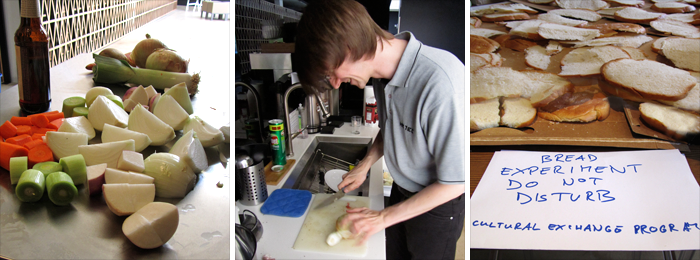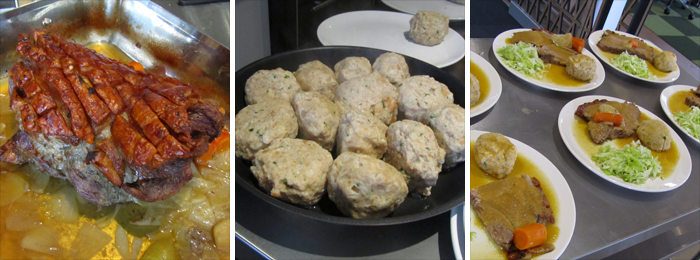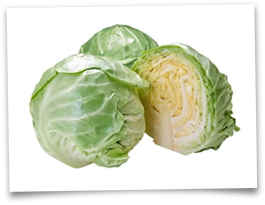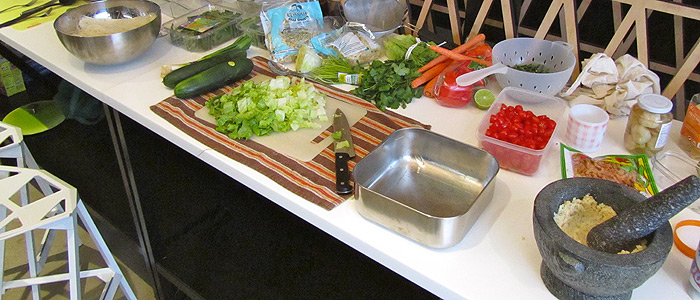Panic recently enjoyed a working visit from our German friends, TheCodingMonkeys. We certainly never expected them to treat us to a home-cooked meal, but treat us they did. Danke, coole Typen! —Neven
Hi, my name is Toby, I work for TheCodingMonkeys, and I love cooking. I live in Bavaria.
So, when we were visiting Panic in Portland, we took the opportunity to bring some Old Europe culture to those American barbarians and cook some traditional Bavarian food. Pork roast is a classic Sunday dish. Fifty years ago, the mother of a family would go to church in the Saturday evening, so she could prepare this meal for the family the next morning and have it ready when they returned from Sunday mass. It takes some time to cook, but it’s not all that complicated.
Cooking for Panic was very enjoyable, not least of all because they have an entire kitchen in their office. What passes for an office kitchen in Europe is usually a tiny room with a coffee cooker and a fridge. Not a four-burner kitchen range with an oven and a sink you could take a bath in. In a word, it was awesome. Add to that Les, our native guide to the jungle of Portland grocery shopping (who was absolutely indispensable), and the rest of the office crew, and you can guess we had a great time.
Thanks again to Panic for having us!
Traditional Bavarian Pork Roast (for 4 persons)
Pork Roast (“Schweinsbraten”)
- 750g (1 1/2 lb) pork shoulder / loin / ham roast, skin-on1
- 2 onions
Veggies:2
- Carrots
- Root parsley (http://en.wikipedia.org/wiki/Parsley#Root_parsley) 3
- Leeks
- Celery root
- Caraway
- Garlic
- Beer
1. This should preferrably be boneless (makes carving easier). You will probably need to specially order this from your butcher beforehand to make sure they leave the skin on the meat.
2. All of the veg are optional and you can use as much or as little of each as you want. Don’t use *too* many carrots though, or their taste’ll come through too strongly. Basically any roots and tubers will do. Even potatoes, in a pinch.
3. You may not be able to get this. We substituted turnip or rutabaga. See 2.
Bread Dumplings (“Semmelknödel”)
- 4 bread rolls4, dried, sliced thinly
- 1 onion
- 2-3 eggs
- salt, pepper, nutmeg
- parsley
- 1/4 l (1 cup) milk
4. Those are German white bread rolls. The bread is similar to a soft French baguette (which is, in fact, a good substitute). We used hamburger buns, which made the dumplings a little sweeter than I’d have liked. Bread dumplings are a food made with leftovers, so make sure the bread is really dry. If you don’t have any old bread lying around, cut fresh bread into slices (1cm [1/2″] thickness), and leave it to dry for a day.
Cabbage Salad (“Kraut”)
- Cabbage5
- Vinegar
- Caraway
5. This particular kind of cabbage, called Weißkraut (“white cabbage”), has pretty tough leaves and looks like this:
This meal has three components: The roast itself, bread dumplings, and a side dish made by marinating chopped cabbage leaves in salt. Let’s call it a cabbage salad for want of a better name.
Also, as with all roasts, the larger the better. The puny 3 lb piece of meat in the recipe will serve four people, but the trouble with very small roasts is that they are done so fast the skin has almost no chance to become crisp. For our American friends, we roasted a magnificent piece of meat weighing more than 3kg, which had the crispest and best crust I’ve ever seen on a pork roast.
The Cabbage Salad, for Lack of a Better Name
I’ll start with this, because you can prepare it way beforehand. Chop the cabbage into very thin strips, put them into a bowl in layers, adding salt (generously) to each layer, and crush the layer with a wooden potato masher or something of the sort. Then, let it rest until 30 minutes before serving.
Half an hour before serving, add vinegar and caraway. Just before serving, add some oil, and (if you feel like it) a finely chopped onion and some pan-roasted bits of bacon.

The Roast
Heat the oven to 200°C (428°F).
Wash the meat, beat it thoroughly with a meat tenderizer, then cut the skin. First, make a series of parallel cuts spaced about 1/2″. Then make a second series of cuts diagonal to the first. Use a sharp knife, a pig’s skin is pretty tough. Be sure to cut all through the skin into the fat layer. Rub the caraway, crushed garlic, salt and pepper all over the meat, the skin, and into the cuts.
Place the meat skin side down into a roasting pan or dutch oven, add a little boiling water, and cover the entire thing with a lid or tinfoil. Put into the oven for 15 minutes. Uncover the meat, turn it skin side up, and add the vegetables.
Roasting time is about 1 hour for every kilo (2 lb) of meat. A meat thermometer is invaluable here, because it lets you make sure the meat is done but not bone dry.
When the skin starts to brown, you can occasionally pour some beer over the meat. It’ll make the skin crisper, and the sauce taste better.
The Sauce
When the you’re nearing the release date, er, serving time – say, about 15 minutes before serving – take out all the vegetables, and mash them through a mesh strainer. Use a ladle to add most of the liquid that’s in the roasting pan, and mix together to make the sauce. At least that’s the traditional way. It gives the sauce a nice grainy texture. Alternatively, you can use a blender, in which case you should blend the veg together with the liquid from the roasting pan.
Season to taste and put the pot with the sauce on the stove so you can warm it back up before serving.
Some people (like me) like the taste of the vegetables that have been cooked for hours in the beer and meat juices. For those people, leave one or two carrots in the roasting pan when you take out the rest to make the sauce.
The Dumplings
You’ll have plenty of time to prepare the dumplings while the roast is roasting. The important part here is getting the consistency of the dough right. Don’t use all the milk at first. Until you mix everything, it’s hard to tell how the dough is going to turn out. After you have added all ingredients, use milk if the dough is too dry. In case disaster strikes (as it did when we were making the dumplings) and the dough gets so liquid you can’t form dumplings out of it, add breadcrumbs.
Pour some of the boiling milk over the dried bread, and let it soak. Add the other ingredients. Yes, all of them. Just toss them in. Go ahead, we do not have all day. Knead everything until homogenous, form dumplings about 3/4 the size of a fist.
About 15 minutes before serving, let the dumplings slide gently into boiling, lightly salted water. (By the way, water takes an incredibly long time to come to a boil, so make sure you put the water on early enough to have it boiling at T minus 15 minutes). Use enough water so the dumplings can float without touching the bottom of the pot. Cook at a soft boil for about 12 minutes.









